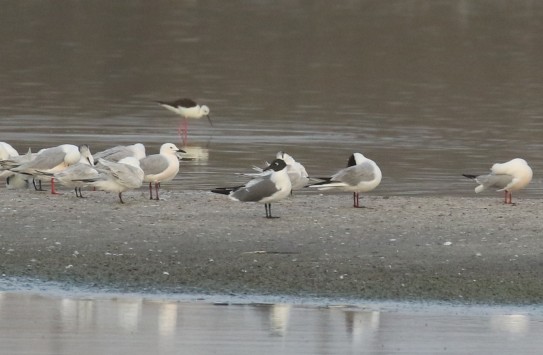Two Laughing Gulls, and other unexpected birds at Technopôle

Another visitor from North America showed up recently at Technopole: a superb adult Laughing Gull (Mouette atricille) was found by Miguel Lecoq and Ignacio Morales over the Easter weekend. First seen on 21.4, it was still present two days later when it was also heard calling. Amazingly, later that same week (25.4), Miguel found an immature (2nd year) in the same place!
Identification is pretty straightforward, the main field characters being nicely visible here: dark grey mantle, almost entirely black outer primaries, narrow white trailing edge to secondaries and tertials, back hood with white “eye lashes”, fairly long dark crimson red bill, and rather long dark red to blackish legs. The young bird is also very distinct and is relatively easy to pick out amongst the numerous other gulls that are present at Technopole at the moment: Slender-billed Gulls mostly, but also Grey-headed Gulls (the immatures of which superficially resemble Laughing Gull), and still some Black-headed, Audouin’s and Lesser Black-backed Gulls (Goeland railler, Mouettes à tête grise et rieuse, Goelands d’Audouin et brun).
Proper rare bird record shot:
This is the fourth American species to be seen in Senegal in less than two weeks, once again highlighting the potential of the country to find vagrant gulls and waders: the overwintering Lesser Yellowlegs (Chevalier à pattes jaunes) was last seen on 8.4, followed by a 2nd year Franklin’s Gull (Mouette de Franklin) on 13.4, the American Golden Plover (Pluvier bronzé) from Palmarin (15.4), and now Larus atricilla. And this is by just a small handful of active observers… just imagine what else there is to be found, if only there were more birders here.
There are just five previous records of Laughing Gull:
- An adult in the Saloum delta on 18.3.85 (Dupuy, A.R. (1985) Sur la présence au Sénégal de Larus atricilla. Alauda 53. Two years earlier, a possible sighting in the same place of a bird apparently paired with Grey-headed Gull, could not be confirmed and should thus be ignored.
- An adult at Guembeul (near Saint-Louis) on 12.1.95 (Yésou P., Triplet P. (1995) La mouette atricille Larus atricilla au Sénégal. Alauda 63)
- A 2nd winter in the Saloum delta on 28.12.05, see picture below (A. Flitti; Recent Reports, Bull. Afr. Bird Club 13)
- One flying past the Ngor seawatch site on 7.10.08 (P. Crouzier, P. J. Dubois, J.-Y. Fremont, E. Rousseau, A. Verneau; Recent Reports, Bull. Afr. Bird Club 16)
- An adult at Saint Louis on 10.1.14; a 2nd winter possibly also present (M. Beevers; Recent Reports, Bull. Afr. Bird Club 21)
Elsewhere on the continent, there are records from Morocco, Mauritania, The Gambia, Guinea-Bissau (first records is yet to be published), and possibly elsewhere – most recently, an imm. photographed at the Bijol Islands in Gambia in December 2018. It’s an annual vagrant to western Europe, even in unexpected locations such as on this lake in the Swiss Alps where an adult overwintered in 2005/2006:

Laughing Gull / Mouette atricille, Merligen, Dec. 2006 (B. Piot)
Unlike Franklin’s Gull, which has been recorded in all months except for November, with most records in May, July and August, Laughing Gull is obviously a species that is more to be expected in winter, with all records so far occurring between October and April.
Other good birds found during Miguel’s frequent visits these past few days include two other additions to the Technopole list: Golden Oriole on 25.4 (Loriot d’Europe), and Pallid Swift on 23.4 (Martinet pâle). A late Mediterranean Gull (Mouette mélanocéphale) was also a good record, as was the count of 606 Sanderlings.
The site list now stands at 237 species. Which one will be next?
Update!
I wrote the preceding paragraphs yesterday, and since then I’ve been – at long last – back to Technopole, as I was up north last weekend and travelling abroad for work this past week. Well, we got the answer: species number 238 is Plain Martin (also known as Brown-throated Martin; Hirondelle paludicole). We had a single bird feeding over the water – often at close range – along with a couple of Barn Swallows (Hirondelle rustique) and several Little Swifts (Martinet des maisons), nicely showing its features. This is a rarely reported species from Senegal, and as it turns out the first eBird observation for the country! It’s rather patchily distributed throughout West Africa, being more common in Morocco, East Africa, and Southern Africa. Considered a non-breeding visitor to Senegal and Gambia, I could only find six old records from Senegal: Morel & Morel list four, followed by one in Jan. 1992 in the Djoudj and one from Mekhe in August 1992. Last year, Bruno Bargain found several at Kambounda (Sédhiou, Casamance), on 2.12.18, but other than those there do not seem to be any recent observations. Very nice sighting and an unexpected addition to my Senegal list – and a cool lifer for Miguel!
Alas no Laughing Gull this morning, but we did see the Frankin’s Gull again. Also another Pallid Swift, as well as new sightings of a colour-ringed German Gull-billed Tern (Sterne hansel) and a Norwegian Common Ringed Plover (Grand Gravelot), plus now two different Med’ Gulls. Let’s try again on Wednesday morning, who knows maybe the gull will be back. It may actually have been around for a few weeks now, as there was a possible sighting at Technopole on March 30th. It’s quite possible that the adult is hanging out by the harbour or elsewhere in the baie de Hann or even Rufisque, and will show up again at Technopole.







































































































































































































Trackbacks / Pingbacks